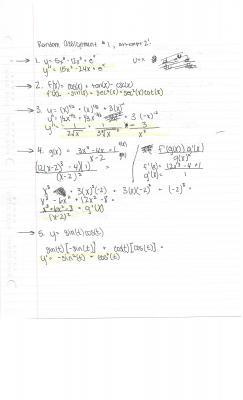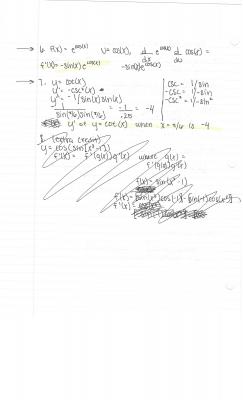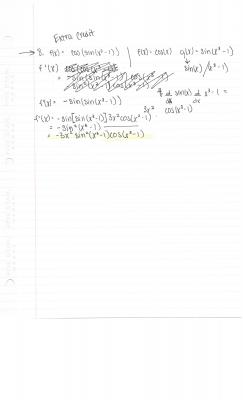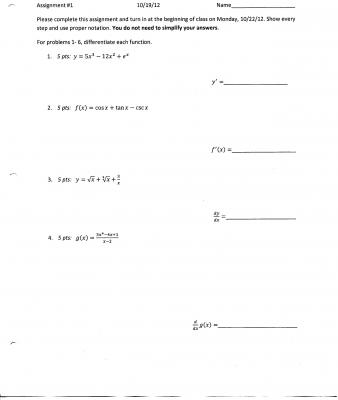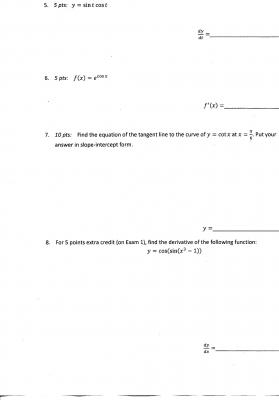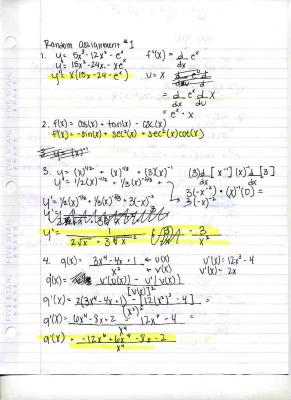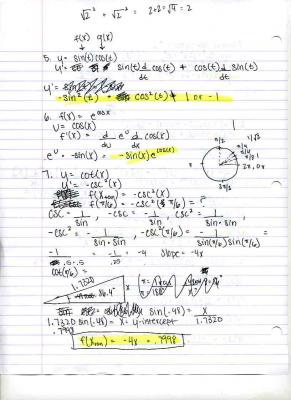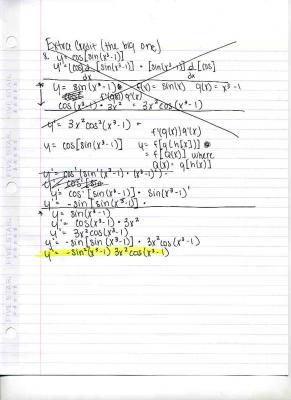

pluripotency
Members-
Posts
11 -
Joined
-
Last visited
Content Type
Profiles
Forums
Events
Everything posted by pluripotency
-

Can someone review answers to Calc 1 assignment?
pluripotency replied to pluripotency's topic in Homework Help
After having a conversation with refsmmat I fixed some fundamental understanding and redid the homework. Attached is version two: -
In the ground state there will be only one orbital (one electron) 1s^1. In an excited state there are theoretically infinite orbitals (it will keep absorbing energy until it no longer feels a magnetic pull from the nucleus and floats away). In the bohr model, the electron will travel in a circle around the nucleus like a planet around the sun. Because the electron happens to occupy a spot in the orbital at π/2 instead of 3π/2 or π/6 does not imply it is in a different orbital even though the uniform circular motion acceleration and velocity vector has changed direction. Is the earth in a different "orbital" ring because it's on the other side of the sun half the time?
-
Of course I want and strive for perfect scores on every assignment, but this one is extra important. My grade comes almost entirely from three tests and I screwed up the first one. This is about my only opportunity to make up for that dent, and in addition, the last question on this assignment adds five raw points to test 1. The assignment is 8 questions long and contains mostly chain rule problems. Attached are 5 scans: 2 are Front/Back of the Assignment Sheet while the other 3 are Front/Back and Front of my attempts to solve. This is rather lengthy of a task to ask someone to review, so feel free to see if and where I went wrong on one or two of the problems and leave the rest for the next person. Thanks so much for helping; kudos, karma, rep, User Rating, whatever to anyone and everyone who helps me get these points!
-
We have our landscaping done once a week. This is taken 4-5 days after it was done last. I started thinking about why this could be that one stem has taken off so rapidly while the others are growing at a normal pace. It's not like it's getting more nutrient or sunlight (or is it?) If this is an obvious question, maybe a link to some hints? Thanks for reading!
-

MFS transporter -> rizosphere colonization
pluripotency replied to pluripotency's topic in Biochemistry and Molecular Biology
Wikipedia (this was also said, albiet worded differently, on a site linked to by BLAST): "transporting small solutes in response to chemiosmotic ion gradients[2][3]." I assumed that by chemiosmotic ion gradient, a term that I learned last quarter in BIOL 160 attributed this to cell resipiration. Thylacoids in chloroplasts and something else about an H+ gradient, although I know that this is obviously for plants, it's the closest connection I have to chemiosmosis. I'll read up more on major facilitator family transporter and how that relates to metabolites and physiological effects, thank you for the pointer edit: Just reporting my findings as I go, I found a really helpful paragraph in the introduction to a long paper about MFS transporters found here http://www.ncbi.nlm.nih.gov/pmc/articles/PMC98904/pdf/mr000001.pdf. It says, It goes on to talk about how there are many different kinds of transporter proteins and MFS proteins are a simple version in comparison to the others such as ABC which can transport macromolcules as well as small molecules, and does not seem to rely on chemiosmotic gradients and instead uses "ATP hydrolysis". -
I need to come up with a reason why an extra gene that codes for an MFS transporter in bacteria would increase colonization in the rizosphere of a plant. So far all I've come up with "the cells can respire better, so it colonizes better". How would I start making more connections? This isn't a test question, it's just a for a paper so any old reason that I can back up and say "disprove this" will suffice. edit: I should note, the gene seems to be unique to this individual, and the individual was selected because of it's rizosphere colonization properties.
-

help understanding methods involved in a phylogenetic analysis
pluripotency replied to pluripotency's topic in Genetics
Thank you for that detailed response Arete. In our paper, the team uses a product they've created called OrthologID to determine relationships between genomes. I assume in this case they've used orthologs in a weighting algorithm that classifies the organisms based on the differences in sequences that are largely the same among all genera. The orthologs the used are determined to be "functional" CharonY that's an interesting point about the ribosomal DNA. In this paper, they're using nuclear DNA. In the past I know they've used mostly plastid DNA (ribosomal I guess in most cases?). Why is it that ribosomal DNA is more useful in creating an evolutionary tree. You said it's under a universal selective pressure, but I'm sure there are genes in nuclear DNA that could be identified and used as a more reliable means of determining evolutionary heritage. Because after all, doesn't nuclear DNA pass down the genome the ribosomes use? -
I think driver mutation is going to refer to a mutation that causes cancerous growth, and passenger mutation is a silent mutation. It's simple to find out which one caused the cancer: compare the cancerous tissue DNA to the normal tissue DNA and look for mutations in the base pairs. If there is a codon that mutated, but ended up coding for the same amino acid, then it is a passenger mutation (or more commonly referred to as a silent mutation). If it coded for a different amino acid then it is a driver mutation and may cause cancerous growth.
-

help understanding methods involved in a phylogenetic analysis
pluripotency replied to pluripotency's topic in Genetics
Okay that makes sense, thank you. Wouldn't you need to compare not only the raw sequences but also the significance of the genes affected? The sequence of an unimportant gene could have changed wildly because it's not selected for, thus telling the algorithm to classify it as another species when in reality it's really the same plant. Are one of the terms I mentioned supposed to account for that? -
I'm trying to read (with at least some comprehension) an article that is covering an analysis of the genomes (and partial genomes) of plants. The took about 150 different species and then attempted to reconstruct their evolution and how related they all are to one another. I need to form a presenation about the methods employed in their research, which is mostly analysis of the individuals' genes. This article is using a lot of words that I don't know and looking up the definitions of the words isn't proving that helpful to my comprehension either. A link to the article is here, with the passage titled "Phylogenetic Analysis" on page 9 being my focus. I need an understanding of terms like Parsimony analysis, Partitioned Bremer support, and what exactly "(bootstrap = 100%)" means. I think this is mostly statistics related...? Thanks so much, I know my questions are vague. Maybe we can just form a discussion on the subject?
-

How do I identify different bacteria on culture plates? Hello everyone,
pluripotency replied to scilearner's topic in Biology
Hello scilearner, I am new to biology too, but I will attempt to answer your question from what I have learned. Someone more experienced should definitely confirm or correct my reply. Streaking is a method by which you're allowing bacterial organisms the chance to form colonies. When you dip your cotton swab or whatever in your broth you have specimen in too high of a density for them to effectively form colonies. When you streak them along your agar plate, you're thinning out the population. Think of an apartment with 40 people inside. These people cannot start families because there is simply not enough resources and space to multiply. When you spread them out over an apartment complex however, there is room in the refrigerator for food and spare bedrooms for cribs. The streaks you are seeing are areas where the population density is too high. The circles are areas where population density is not affecting reproduction. Here is a picture of a failed streak plate. Even after streaking, there was still no colonization by the organisms. To answer your question about agar, I think that most bacteria can grow on agar medium (which is derived from seaweed). For some types of bacteria, there may be specialized agar which promotes colonization better but on that I am not sure. I hope this helped!

